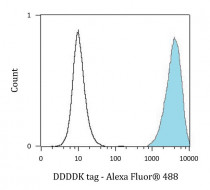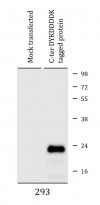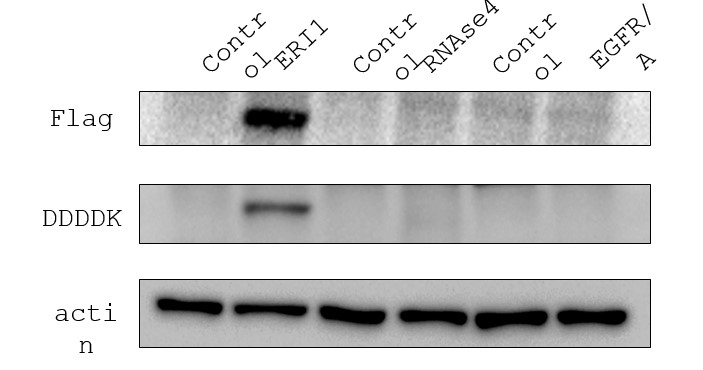ARG66332
anti-DDDDK tag antibody [SQab1880]
anti-DDDDK tag antibody [SQab1880] for Flow cytometry,ICC/IF,Immunoprecipitation,Western blot and Other
Controls and Markers antibody; Tag Internal Control antibody

Overview
| Product Description | Recombinant Rabbit Monoclonal antibody [SQab1880] recognizes DDDDK tag (Equivalent to Sigma's anti-FLAG antibodies). The antibody recognizes the hydrophilic epitope tagging peptide sequence DDDDK (Asp-Asp-Asp-Asp-Lys), when fused to either the amino- or carboxyl- terminus or at an internal site on target proteins. |
|---|---|
| Tested Reactivity | Other |
| Tested Application | FACS, ICC/IF, IP, WB |
| Host | Rabbit |
| Clonality | Monoclonal |
| Clone | SQab1880 |
| Isotype | IgG |
| Target Name | DDDDK tag |
| Antigen Species | Others |
| Immunogen | KLH-conjugated DYKDDDDK. |
| Conjugation | Un-conjugated |
Application Instructions
| Application Suggestion |
|
||||||||||
|---|---|---|---|---|---|---|---|---|---|---|---|
| Application Note | * The dilutions indicate recommended starting dilutions and the optimal dilutions or concentrations should be determined by the scientist. |
Properties
| Form | Liquid |
|---|---|
| Purification | Purification with Protein A. |
| Buffer | PBS, 0.01% Sodium azide, 40% Glycerol and 0.05% BSA. |
| Preservative | 0.01% Sodium azide |
| Stabilizer | 40% Glycerol and 0.05% BSA |
| Storage Instruction | For continuous use, store undiluted antibody at 2-8°C for up to a week. For long-term storage, aliquot and store at -20°C. Storage in frost free freezers is not recommended. Avoid repeated freeze/thaw cycles. Suggest spin the vial prior to opening. The antibody solution should be gently mixed before use. |
| Note | For laboratory research only, not for drug, diagnostic or other use. |
Bioinformation
| Research Area | Controls and Markers antibody; Tag Internal Control antibody |
|---|
Images (5) Click the Picture to Zoom In
-
ARG66332 anti-DDDDK tag antibody [SQab1880] ICC/IF image
Immunofluorescence: 293 cells trasnfected with C-terminal DYKDDDDK tagged gene. Cells were fixed with 4% paraformaldehyde for 30 min at RT, permeabilized with 0.1% Triton X-100 for 10 min at RT then blocked with 10% goat serum for 30 min at RT. Cells were stained with DAPI (left) or ARG66332 anti-DDDDK tag antibody [SQab1880] at 1:10000 and 4°C (right).
-
ARG66332 anti-DDDDK tag antibody [SQab1880] FACS image
Flow Cytometry: 293 cells transfected with N-terminal DYKDDDDK tagged gene. The cells were fixed with 4% paraformaldehyde (10 min) and then permeabilized with 0.1% TritonX-100 for 15 min. The cells were stained with ARG66332 anti-DDDDK tag antibody [SQab1880] (light blue histogram) at 1:2000 dilution in 1x PBS/1% BSA for 30 min at RT, followed by Alexa Fluor® 488 labelled secondary antibody. Unlabelled sample (white histogram) was used as a control.
-
ARG66332 anti-DDDDK tag antibody [SQab1880] WB image
Western blot: Testing of ARG66332 anti-DDDDK tag antibody [SQab1880]. 3 µg of 293 cell lysate without any transfection (ARG66332 at 1:2000, left) or transfected with N-terminal DYKDDDDK tagged gene (ARG66332 at 1:10000, right).
-
ARG66332 anti-DDDDK tag antibody [SQab1880] IP image
Immunoprecipitation: 0.1 mg of 293 whole cells lysate transfected with N-terminal His tagged gene immunoprecipitated (1:50) and stained with ARG66332 anti-DDDDK tag antibody [SQab1880]. 1) PBS (Control) and 2) Primary antibody.
-
ARG66332 anti-DDDDK tag antibody [SQab1880] WB image
Western blot: Testing of ARG66332 anti-DDDDK tag antibody [SQab1880]. 3 µg of 293 cell lysate without any transfection (ARG66332 at 1:2000, left) or transfected with C-terminal DYKDDDDK tagged gene (ARG66332 at 1:100000, right).
Customer's Feedback














